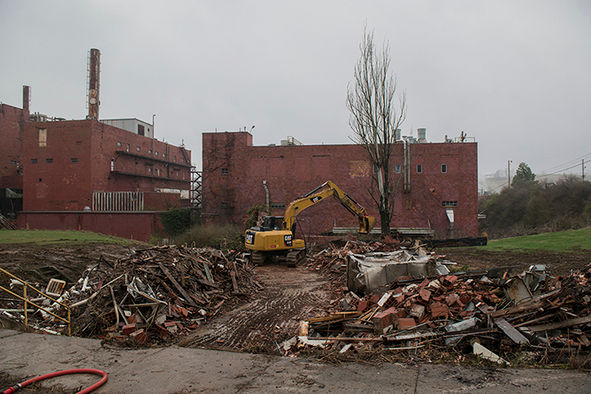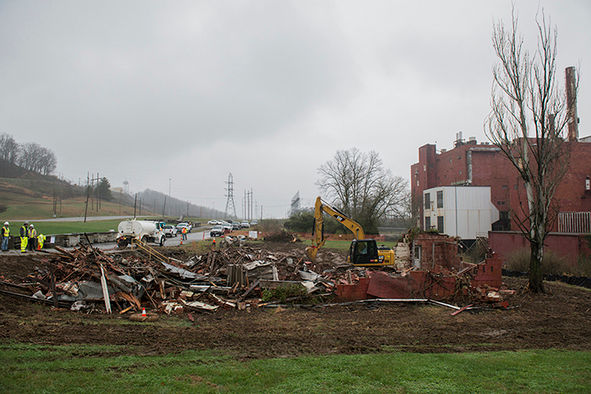
Crews tear down Building 9743-2 at the Biology Complex at the Y-12 National Security Complex. (Photo by U.S. Department of Energy Office of Environmental Management)
By U.S. Department of Energy Office of Environmental Management
Oak Ridge is home to more higher-risk excess contaminated facilities than any other U.S. Department of Energy site in the nation, but recent demolition projects are helping change that. This month, the Oak Ridge Office of Environmental Management, or OREM, eliminated two buildings from the higher-risk list.
The projects were part of DOE’s Excess Contaminated Facilities Initiative, an effort to stabilize facilities, reduce risks, and in some cases accelerate demolition schedules. Oak Ridge is of particular interest since the site houses 297 “excess” facilities—facilities that are no longer operational or serving DOE’s missions. As of December 2016, Oak Ridge contained 60 of DOE’s inventory of 203 higher-risk excess facilities.
“These projects are highlighting EM’s value as crews are removing risks and clearing land for DOE’s important ongoing missions,” said OREM Federal Project Director Brian Henry. “Tearing down these high-risk facilities is a first step with many more planned in the years ahead.”
OREM recently removed two higher-risk excess contaminated facilities. Oak Ridge contains more higher-risk facilities than any other DOE site.
Both buildings that were removed, the Radiation Source Building and another used for biological research, were part of the Y-12 National Security Complex’s Biology Complex. The buildings, which are owned by the DOE Office of Science at a National Nuclear Security Administration site, have been vacant since 2000, and they are deteriorated due to their age. Removing the buildings allows the location to be used for modern national defense missions.
Originally constructed to recover uranium from process streams, the complex later housed DOE’s research on the genetic effects of radiation from the late 1940s. When operational, the facilities once housed more individuals with doctorates than anywhere in the world. These men and women radically enhanced the world’s knowledge in biology, including the discovery of the Y chromosome.
The Biology Complex previously consisted of 12 buildings until OREM demolished four of them in 2010 as part of the American Recovery and Reinvestment Act. After last week’s activities, only six remain now. The goal is to complete demolition in the early 2020s.
Contributor: Ben Williams
This story and photos originally appeared in the electronic edition of “EM Update,” which was published by the DOE Office of Environmental Management on Tuesday, March 13.

The U.S. Department of Energy’s Oak Ridge Office of Environmental Management recently removed two higher-risk excess contaminated facilities at the Biology Complex at the Y-12 National Security Complex. Oak Ridge contains more higher-risk facilities than any other DOE site. Pictured above is the Radiation Source Building. (Photo by DOE Office of Environmental Management)

The U.S. Department of Energy’s Oak Ridge Office of Environmental Management recently removed two higher-risk excess contaminated facilities at the Biology Complex at the Y-12 National Security Complex. Oak Ridge contains more higher-risk facilities than any other DOE site. Pictured above is the Radiation Source Building. (Photo by DOE Office of Environmental Management)
More information will be added as it becomes available.
Do you appreciate this story or our work in general? If so, please consider a monthly subscription to Oak Ridge Today. See our Subscribe page here. Thank you for reading Oak Ridge Today.
Copyright 2018 Oak Ridge Today. All rights reserved. This material may not be published, broadcast, rewritten, or redistributed.
Leave a Reply